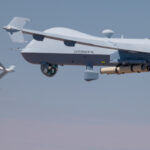
A good 2019 keeps rolling for Lockheed Martin [LMT] as the company reported strong increases in earnings and sales in its second quarter, building on handsome gains in the first quarter. The strong results led the company to increase its guidance for sales, earnings and cash this year. Net income in the quarter increased 22 percent to just over $1.4 billion, $5 earnings per share (EPS), from just under $1.2 billion ($4.05 EPS) a year ago. Each of the company’s…

 By
By 











